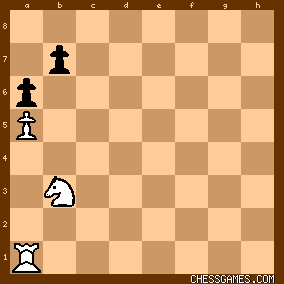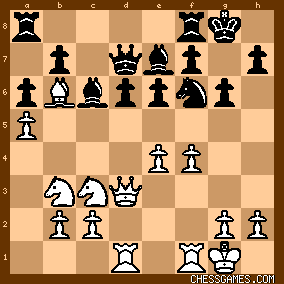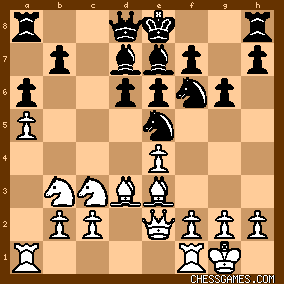|
< Earlier Kibitzing · PAGE 295 OF 1067 ·
Later Kibitzing> |
| Sep-24-06 | | Tomlinsky: Having now played a4, isn't the next move in the sequence a5 a fait accompli? Wasn't that the whole intention of making the move as presented unless Arno threw a spanner in the works and caused obstruction in some way? It is move 12 The World should be looking at now if it has any intention of being consistant in their objectives not move 11. Otherwise the net result will be spending four days reassessing a move that should have been clarified within the first two. That's not even counting the extra day of being able to think in Arno's time. No? |
|
| Sep-24-06 | | SniperOnG7: <patzer2> so are you saying that even if Black cannot go for ...b7-b5 anymore, ...b6 is still a good move for him and hence 11.a5 is the best choice? |
|
| Sep-24-06 | | NateDawg: <Tomlinsky> The reasons for 11.a5 are twofold. First, it prevents Black from playing ...b6 and developing his queenside bishop at b7. He is instead forced to put it at d7 and then probably c6, where it can be exchanged off by ♘d4. Second, a pawn at a5 allows a White piece (preferably a Bishop since this defends the pawn) to go to b6. Another asset of ♗b6 is that it makes Black's queen go to an inferior square. If Black's bishop is still at c8, then the queen at d7 locks it in. If Black's bishop is at d7, then his queen must retreat to c8 or e8. This is why 11.a5 is the best move in this position. |
|
| Sep-24-06 | | SniperOnG7: Ah <NateDawg> you have answered my question. Yes, im persuaded. I'll change my vote to 11.a5 |
|
| Sep-24-06 | | RookFile: Let's go back to the 6th move of the game.

click for larger viewIn this position, the world decided to play the move 6. Nb3, and black retreated with 6....Be7. How should we evaluate this transaction? On the face of it, it appears to have favored black.
After all, the knight on b3 was decentralized, and black retreated his bishop to a perfectly reasonable square, e7. Did black gain a move for free? Are we obligated to move the knight back to d4, or perhaps to d2, in order for this piece
to be effective?
Anatoly Karpov had a way of playing chess. In game after game, this philosophy came out. It can be summarized as follows:
"Give the opponent what he wants, and then show him that what he wanted wasn't so great after all." He also had another
mindset - "I'm here to win - period. No nonsense - I'm going to play straightforward chess and just beat you." How can we follow this? How can we give black what he wanted, and then show him that what he wanted wasn't so wonderful
after all?
The answer is - and this is the only answer - that we must pursue a plan that demonstrates that knight on b3 is an effective piece
- RIGHT WHERE IT IS.
In his last book, "Last Lectures" (material by Capablanca put into book form after his death) - practically the very first topic
Capablanca covers is: "one pawn that holds two". That is the type of mini bind that we have an opportunity to achieve here. 
click for larger viewThis setup presents black with a quandry. The queenside is the main source of black's counterplay in the Sicilian. Here,
we are on the verge of compeletely snuffing out black counterplay. Once we've achieved this, we have a free hand on the kingside to
expand with a plan like f4 and f5, blowing up black's king. And we can take our time doing this, with black's counterplay first neutralized. Consider:
A) if the black pawn ever pushes to b6, we take it, and put a knight on a5, blockading the a6 pawn, and the knight
prevents black's bishop from setting up an effective post on the a8/h1 diagonal. B) If no action is taken, the knight on b1 goes to c3, a4, and then b6, where it really ends any hope of black
queenside play.
A ha! But doesn't black have a knight on f6 that can go to d7 and swap itself for the knight on b6? Would that we be so lucky if black did this!! Why? Because it is not really on the queenside that we are going to win this game.
No - there is another natural weakness of black's. Where I come from, playing an opening that involves moving pawns to e6
and g6 is inviting yourself to get mated by a kingside attack. Motylev vs Svidler, 2003
This game was agreed drawn, because 2765 rated Svidler outrated his opponent, and knew when to take the draw with black.
Yet I submit to you, this position is favorable for white. I think we have a chance to have an even more favorable position
than what white got - either we have a knight sitting there on b6, paralyzing the queenside, or black moves his knight
over from f6 to d7 to challenge it. Oh I sure hope he does! Removing that knight from the kingside is often a key ingredient to
a successful kingside attack!
|
|
| Sep-24-06 | | weisyschwarz: a5 was played by four grandmasters? Well, maybe GMs 2,3,and 4 followed GM 1 unthinkingly. Where are those Karpov games? ♘c3 |
|
| Sep-24-06 | | Tomlinsky: I understand what a4 is about. It's coherency of the original plan behind it I am picking up on and trying to save wasted time. Also, it does NOT prevent black from developing a bishop on b7 if he wishes. It hinders it but it doesn't prevent it. If black, for example and from my experience, wishes to open the b file and put, say a rook on b8 with a bishop in front of it (maybe retracting it to a8) he can. It was a false argument to say that it prevents Bb7 because if black wishes to build it into his plans he can. Also, just plonking a piece on b6 is weak. There is no power in the move unless the piece is supported and we are still half way through development at the moment. Anyway, just trying to save some time here. :)
|
|
| Sep-24-06 | | RandomVisitor: 21-ply analysis in progress:

click for larger viewAnalysis by Rybka 2.1c mp:
1. = (0.19): 11.a5 Nf6 12.Nc3 0-0 13.Bg5 Bd7 14.f4 Nxd3 15.Qxd3 Rc8 16.Rf3 Bc6 17.Nd4 Re8 2. = (0.19): 11.Nc3 Nf6 12.Bg5 Bd7 13.a5 Nxd3 14.Qxd3 0-0 15.Rfd1 Bc6 16.Nd4 Bd7 17.h3 Qc7 3. = (0.14): 11.Rd1 Nf6 12.Nc3 0-0 13.a5 Bd7 14.Bg5 Re8 15.h3 Rc8 16.Qd2 Nxd3 17.Qxd3 d5 4. = (0.12): 11.Bd2 Nf6 12.Nc3 0-0 13.Bg5 Bd7 14.a5 Bc6 15.Nd4 Nxd3 16.Qxd3 d5 17.e5 Nd7 5. = (0.10): 11.Be3 Nf6 12.Nc3 0-0 13.Bg5 Bd7 14.a5 Bc6 15.Nd4 Nxd3 16.Qxd3 d5 17.e5 Nd7 6. = (0.10): 11.f3 Bf6 12.Nc3 Ne7 13.Bh6 g5 14.f4 gxf4 15.Bxf4 N7g6 16.Be3 Rg8 17.a5 Bd7 7. = (0.09): 11.h3 Nf6 12.Nc3 0-0 13.a5 Bd7 14.Be3 Re8 15.Rfd1 Qc7 16.Bb6 Qb8 17.Qe3 Qc8 8. = (0.09): 11.Qd1 Nf6 12.Nc3 d5 13.Bf4 Nxd3 14.Qxd3 dxe4 15.Qe2 0-0 16.Rfd1 Bd7 17.Nxe4 Nxe4 9. = (0.09): 11.Na3 Nf6 12.Bh6 Bd7 13.Nc4 Nfg4 14.Nxe5 Nxe5 15.Qd2 g5 16.f4 Nxd3 17.Qxd3 gxf4 10. = (0.06): 11.Kh1 Nf6 12.Nc3 0-0 13.Bg5 Nxd3 14.Qxd3 e5 15.Bxf6 Bxf6 16.Rfd1 Bg4 17.f3 Be6 (, 24.09.2006)
|
|
Sep-24-06
 | | Domdaniel: <NateDawg> Quick comment on your line:
(1) it assumes Black goes for the ...Bf6/Ne7/0-0 idea. I know I made the same assumption earlier about a possible line after 11.Na3, but it's far from Black's only option.
Specifically, I don't like the look of his ...Qd7. He might be able to play ...Qe8 instead, following with something like ...Bd7 and ...Nc8. It's a little messy, but I think it holds. Perhaps all this really shows is that the ...Ne7/0-0 idea isn't Black's best - whether we play 11.a5, 11.Na3 or 11.(wince)Nc3... btw, how come nobody's voting for the other move apart from a5 that's actually been played here before - twice that I know of, with a 75% score - 11.h3 !?! **11.Na3 Fans - check my Forum**
Signing out now. G'night all. |
|
| Sep-24-06 | | SniperOnG7: <Rookfile> that last post of yours is really insightful. Keep up the good work. |
|
| Sep-24-06 | | RandomVisitor: 25-ply analysis in progress (top move completed): score +0.15 2: World - Nickel, corr 2006 x 2006

click for larger viewAnalysis by Rybka 2.1c mp:
11.Nc3 Bd7 12.a5 Nf6 13.Bg5 0-0 14.f4 Nxd3 15.Qxd3 Rc8 16.Rad1 Bc6 17.f5 exf5
= (0.15) Depth: 25 03:31:34 14699307kN
(, x 24.09.2006)
|
|
Sep-24-06
 | | Domdaniel: <weisy> There are no Karpov games, because we're playing a line that hadn't been invented in Karpov's 1970s heyday. RookFile is reasoning by analogy - saying that this was Karpov's plan in broadly similar positions. Actually, I think he has a point - I remember those Karpov games. But I haven't found one in a line that's close enough to this to be convincing. |
|
Sep-24-06
 | | Domdaniel: <RandomVisitor> so the difference between out best and 10th-best moves, according to Rybka, is roughly 1/7th of a pawn? Hmm. |
|
| Sep-24-06 | | NateDawg: <Thorsson:<You quote: 11.a5 Nf6 12.Nc3 Bd7 13.f4 Nxd3 14.Qxd3 0-0 15.Be3 Bc6 16.f5 etc., but Black will play 14...Bc6 15.Be3 d5 and his worries are over.>> I have realized that is probably best to play ♗e3 on move 13. Also, this time I'm using Chessmaster 10, since you say Fritz is bad for this type of position. 11.a5 ♘f6 12.♘c3 ♗d7 13.♗e3 ♗c6 14.f4 ♘xd3 15.♗b6 ♕d7 16.♕xd3 0-0 17.♖ad1 d5 18.e5 ♘h5 19.♘d4 ♖fc8 
click for larger viewWhite can open the game up with 20.g4 ♘g7 21.f5 or keep it closed with 20.♕h3. Chessmaster 10th Edition gives this postion (0.83), Crafty 19.19 gives it (0.56), and my buddy Fritz 9 gives it (1.43). |
|
| Sep-24-06 | | PrinceRepulsive: Half the point of playing a4 was so that we could continue with a5. No problem for me here. |
|
| Sep-24-06 | | NateDawg: <RandomVisitor> Could you please have Rybka analyze the variations with 11.a5 ♘f6 12.♘c3 ♗d7 13.♗e3 0-0 14.f4 ♘xd3 15.♗b6? Thanks. |
|
Sep-24-06
 | | Ron: Thanks for the computer analysis <RandomVisitor> : it seems now that the world team, if it has an advantage, is minimal. |
|
| Sep-24-06 | | RandomVisitor: <NateDawg>Ok...setting Rybka to that position... |
|
| Sep-24-06 | | RandomVisitor: <NateDawg>I think you mean 13...Bc6, right? |
|
| Sep-24-06 | | weisyschwarz: I don't have a Rybka or Shredder or anything like that. But I just played the moves out on the little Java Chess, the one connected with LCP, and wouldn't you know the little engine (20 sec/move) also figured on a5 as a way to free f4. I added the Black moves: 11.a5 Nf6 12.Nc3 Bd7 13.f4 Nxd3 14.cxd3
a5 keeps the Black Q away from checking after f4. |
|
| Sep-24-06 | | NateDawg: <Random Visitor:<I think you mean 13...Bc6, right?>> We would have to consider both moves. They are similar; you can analyze either or both - I think the results will be about the same. |
|
| Sep-24-06 | | RandomVisitor: <NAteDawg>In the 11.a5 Nf6 12.Nc3 Bd7 13.Be3 Bc6 14.f4 Nxd3 15.Bb6 Qd7 16.Qxd3 0-0 17.Rad1 d5 18.e5 Nh5 19.Nd4 Rfc8 line, Rybka sees 17...Qc8 as better (possibly freeing d7 for the knight) with the following lines as possibilities:
Rybka 2.1c mp - ,x, Blitz:4'+2"

click for larger viewAnalysis by Rybka 2.1c mp:
1. = (0.12): 17...Qc8 18.Nd4 d5 19.exd5 Bxd5 20.Qe3 Bc4 21.Rf3 Nd5 22.Nxd5 Bxd5 23.Rf2 Re8 24.b3 2. = (0.21): 17...Bb5 18.Nxb5 Qxb5 19.c4 Qh5 20.Rf3 Rac8 21.Rdf1 Rfe8 22.Rh3 Qg4 23.Rg3 Qh4 24.Nd4 3. = (0.24): 17...Rac8 18.Nd4 d5 19.e5 Ne4 20.Nxe4 dxe4 21.Qe3 Bb5 22.Rfe1 Bc6 23.Nxc6 Qxc6 24.Rd2 (, 24.09.2006)
|
|
| Sep-24-06 | | Billosky: It looks to me like our bishop on d3 is a "gone-er" whether we play a5 or Nc3, or almost anything else for that matter. Are the first two lines given by <RandomVisitor>'s analysis the only two likely to come into play? If so, isn't a5 slightly better? |
|
| Sep-24-06 | | NateDawg: <RandomVisitor> Thanks for the analysis. |
|
| Sep-24-06 | | RandomVisitor: <NateDawg>More Rybka analysis: Rybka does not see white getting any kind of advantage in this line.
Rybka 2.1c mp - ,x, Blitz:4'+2"

click for larger viewAnalysis by Rybka 2.1c mp:
1. = (0.13): 13...0-0 14.f4 Nxd3 15.cxd3 Rc8 16.e5 Nd5 17.Nxd5 exd5 18.Bb6 Qe8 19.Rac1 Rxc1 20.Rxc1 2. = (0.14): 13...Nxd3 14.Qxd3 0-0 15.Rfd1 Rc8 16.Bh6 Re8 17.Bg5 d5 18.e5 Nh5 19.Bxe7 Qxe7 20.Qe3 3. = (0.17): 13...Qc7 14.Bb6 Qc8 15.f4 Nxd3 16.cxd3 Bc6 17.Nd4 0-0 18.Nxc6 Qxc6 19.Rac1 Rac8 20.Qf3 (, 24.09.2006)
|
|
 |
 |
|
< Earlier Kibitzing · PAGE 295 OF 1067 ·
Later Kibitzing> |








